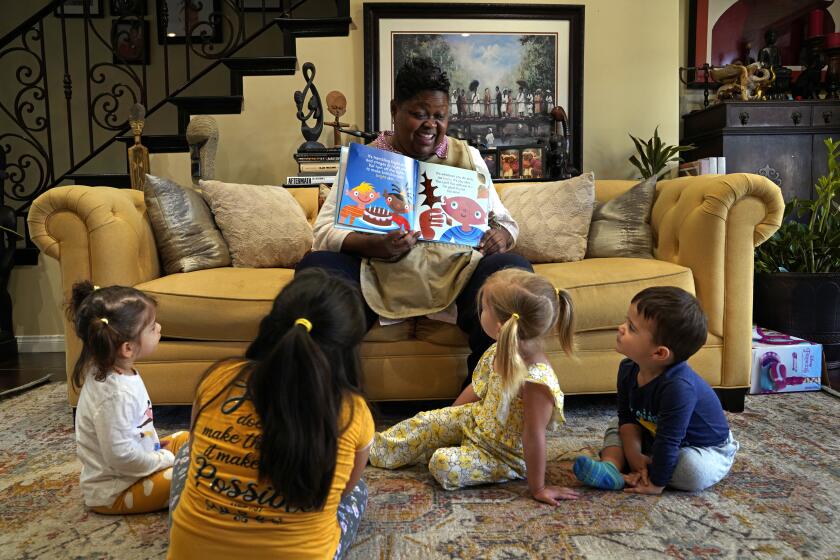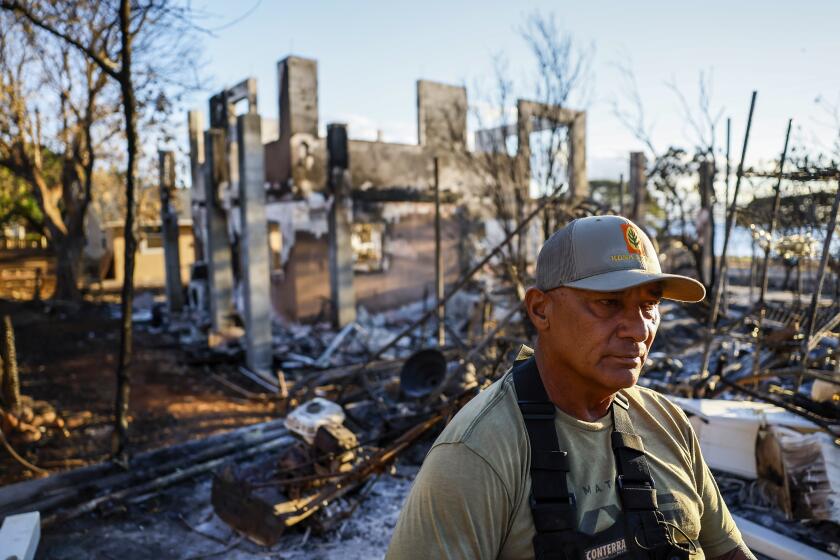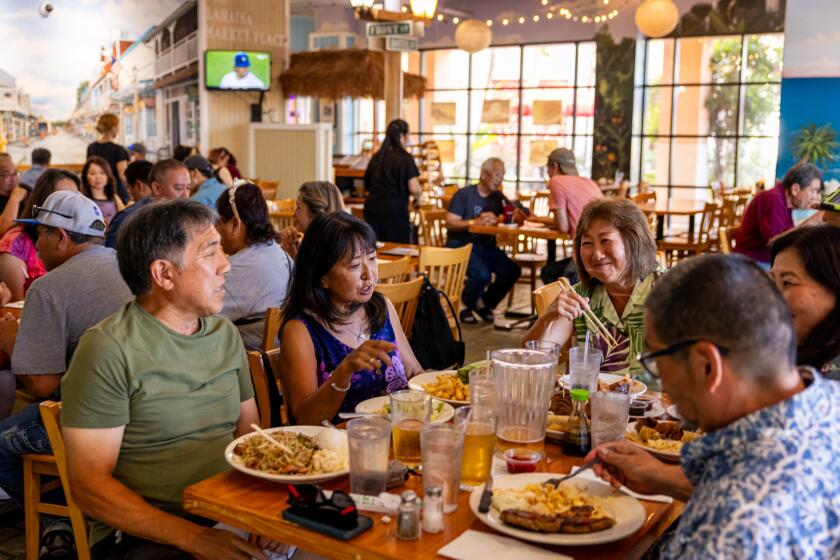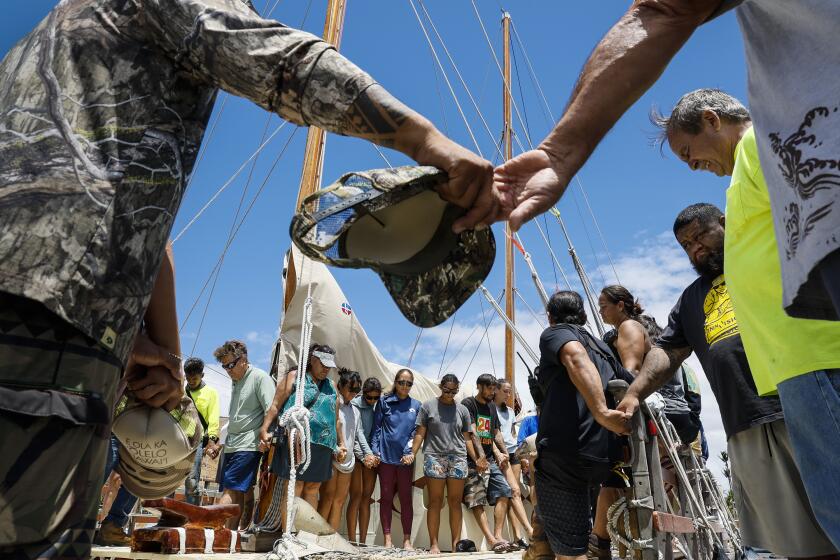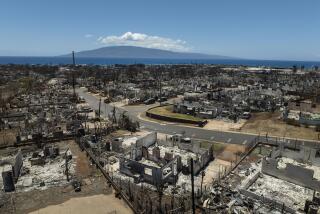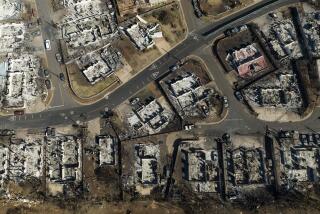Maui fires take a toll on survivors’ mental health
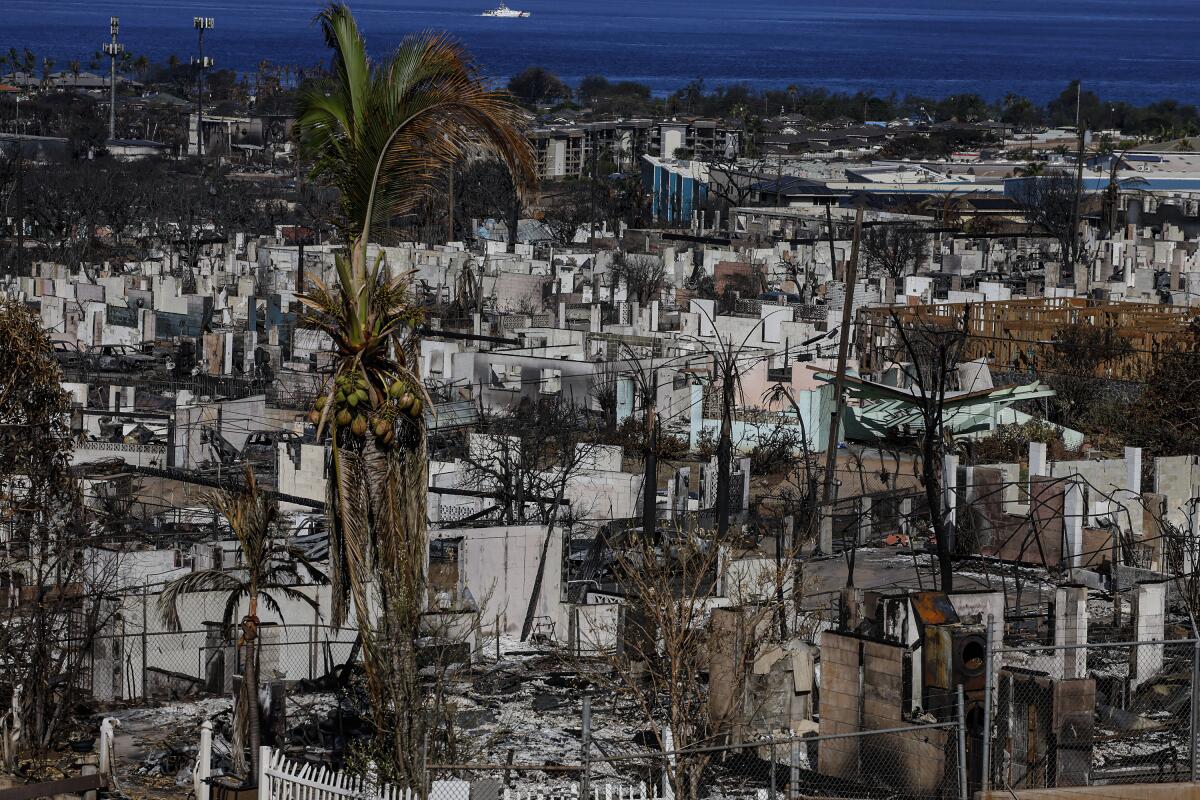
- Share via
As recovery efforts stretch into a ninth day following the devastating and deadly wildfire in Maui, concern is also turning to the mental health of those picking up the pieces.
Spiritual care teams have set up throughout western Maui to pray, talk and listen, Salvation Army Maj. Troy Trimmer said. Many, he said, simply need a “ministry of presence.”
Trimmer recounted how some volunteers brought hot meals to a family who initially refused the assistance. “Give it to someone else,” they said.
“No, we’ve been specifically asked to go find you,” the volunteers replied.
“The amount of stress that came off that family — the ability to just talk stories, and the ability of our team to just be present with them” — was palpable, Trimmer said.
Registering loss after such a catastrophic event usually takes two phases, said Christian Burgess, the director of Vibrant Emotional Health’s disaster distress helpline. In the immediate aftermath, people feel overwhelmed, anxious and isolated, “because of the rush of the feeling that there is an out-of-control situation,” he said. Survivors — especially caregivers, parents and pet owners — focus on immediate, practical resources to help regain control and quell anxiety.
“What we should expect to see in [the] coming weeks is risk for more serious mental health concerns,” Burgess said, such as depression, severe anxiety and substance abuse issues. “Headlines start to shift, people start to feel even more isolated. Those feelings of depression start to settle in and people start to take stock of their losses.”
A list of crisis hotlines, low-fee and sliding scale counseling, support groups, and mindfulness and meditation services
Burgess said this second phase is when calls to disaster distress helplines start coming in, as people struggle to sleep or get through the night.
“It is important they know that they’re not alone,” Burgess said. Mental health services can be reached around the clock by calling 988.
Volunteers from Church of the Brethren, an Anabaptist Christian congregation, recently landed on the island bringing “kits of comfort” — packs of toys, activities and crafts for children, said Roy Winter, executive director of service ministries. The volunteers are stationed in family assistance centers, to watch children and give parents a break.
“Of course it’s also just a chance for children to simply have fun and be a kid again,” Winter said. “Sometimes getting to play for the first time since the disaster happened.”
Over a week after fire incinerated Lahaina, locals are pressing for a return to work as they seek some sense of normalcy.
The death toll from the fire has risen to 111, with 38% of the burn zone searched, authorities said Thursday. Family and friends have held out hope for missing loved ones, as more than 1,000 people remain unaccounted for.
Herman Andaya, head of Maui’s Emergency Management Agency, resigned from his post Thursday, citing health reasons.
His resignation comes the day after he publicly defended his decision not to use the island’s outdoor siren system during the Lahaina fire, with his comments generating widespread condemnation and media scrutiny.
At a news conference Wednesday, Andaya said the siren system was designed for tsunamis, not wildfires, and is not part of the agency’s standard response protocol.
“The public is trained to seek higher ground in the event that the siren has sounded,” he said.
The agency used several other types of emergency notifications to alert people to the fire, Andaya said. Wireless emergency alerts, which send text messages to residents, and an emergency alert system, which broadcasts emergency notifications via television and radio, were used. Other local alert systems, such as MEMA alerts, have been used in the past.
“It is our practice to use the most effective means of conveying an emergency message to the public during a wildland fire,” Andaya said.
Legendary big-wave surfer Archie Kalepa has turned his home in Lahaina into a well-orchestrated supply depot for survivors of the devastating fire.
Later on in the news conference, Hawaii Gov. Josh Green backed Andaya’s assessment of the sirens, recounting his own experience when he came to the state to practice medicine.
“When I first moved to Hawaii, people told me if you hear a siren, it’s a tsunami and go to high ground,” Green said.
The governor also addressed concerns about potential developers swooping in and buying up land in the decimated areas. Green said the state’s attorney general is pursuing a temporary moratorium on purchases, adding that the government would not issue new permits.
“That doesn’t mean that we don’t want people to invest in Hawaii and travel to Hawaii, away from the impact zone,” Green said. “What it means is people right now are traumatized. Please don’t approach them with an offer to buy land. Please don’t approach their families to tell them that they’ll be better off if they make a deal. Because we’re not going to allow it.”
Building in the fire zone will come after a long period of recovery, Green said.
After fires destroyed most of the town of Lahaina on West Maui, diners gathered at the Carson restaurant Back Home in Lahaina to grieve, celebrate and build community over music and plates of Hawaiian food
Support staff from Hawaii’s Office of Wellness and Resilience are on the ground, Green said, to counsel Hawaiians as they grapple with the fires’ aftermath. Mental health specialists from the American Red Cross and the Federal Emergency Management Agency have joined them, according to FEMA administrator Deanne Criswell.
“This community is going through one of the worst things that we could possibly imagine and the mental health concerns are real,” Criswell said at a news conference at the White House on Wednesday.
Authorities released the names of three more of the more than 100 victims: Melva Benjamin, 71; Virginia Dofa, 90; and Alfredo Galinato, 79. Previously, Robert Dyckman, 74, and Buddy Jantoc, 79, were identified. All were from Lahaina.
Current and former pro athletes from Hawaii are helping those affected by the Maui fire, which killed more than 100 people, with about 1,300 still missing.
The search for human remains has been slow and methodical, with crews sifting through still-hot ruins. Efforts have expanded in recent days, with at least 30 teams of cadaver dogs on the ground and more set to arrive. Mortuary experts from the U.S. Department of Health and Human Services arrived earlier this week, along with tons of equipment and supplies, including a portable morgue, to facilitate efforts to process and identify victims.
With one of the two major highways into Lahaina reopened Wednesday, survivors have begun returning to their homes for the first time since the blaze swept through eight days ago and others began to return to work on West Maui. Officials said the Lahaina fire was 89% contained Wednesday.
Times staff writers Alexandra E. Petri and Julia Wick contributed to this report.
More to Read
Sign up for Essential California
The most important California stories and recommendations in your inbox every morning.
You may occasionally receive promotional content from the Los Angeles Times.
